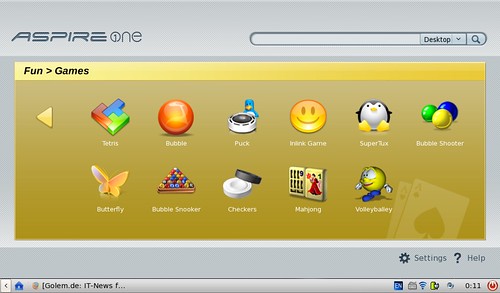 A few weeks ago I became the proud owner of an Acer Aspire One Linux edition (reviewed here). Out of the box, this little wonder comes with the relatively unknown Linux distribution Linpus Linux Lite, which has been customized somewhat by Acer to make the most of the hardware in the Aspire One. The screenshot above and many more pictures of Acer’s version of Linpus are available at Golem.de, or you can find captures of the vanilla Linpus Lite 9.4 here.
A few weeks ago I became the proud owner of an Acer Aspire One Linux edition (reviewed here). Out of the box, this little wonder comes with the relatively unknown Linux distribution Linpus Linux Lite, which has been customized somewhat by Acer to make the most of the hardware in the Aspire One. The screenshot above and many more pictures of Acer’s version of Linpus are available at Golem.de, or you can find captures of the vanilla Linpus Lite 9.4 here. The installation is indeed very ‘Lite’, and brings up the desktop from suspend in less than 10 seconds, or from cold boot in around 20 seconds. Part of the reason for these amazing startup times is that Linpus doesn’t attempt to start up a fully blown integrated desktop environment like Gnome or KDE, and is in fact based on XFCE, including the XFCE’s Terminal and Thunar Filemanager.
A big selling point for Linpus is it’s support for Asian languages out of the box, and the Acer version is no exception: I was able to type Thai characters with the default setup, and there are additional smart input managers for Korean, Japanese and both Simplified Chinese and Traditional Chinese.
Under the hood, Linpus is actually based on Fedora Core 8, which betrays its age a little since Fedora itself left that release behind some time ago. That does, however, mean that with a little digging it’s possible to turn on the more advanced features we are used to seeing on a desktop class machine. Pressing ALT+F2 brings up a useful launch prompt, from which you can start the XFCE preference manager that Linpus doesn’t reveal by default — the so-called “Advanced Mode Hack. From here, all of XFCE’s options can be customized, including turning on the right-click desktop menu. Having done that, all of Fedora Core’s installed applications can be found inside this desktop menu, including the Fedora Package Manager.
In theory, the sky would be the limit here. Unfortunately it’s not entirely safe to add a bunch of Fedora 8 package repositories and let fly, since the patched Linpus packages are sometimes lagging behind the Fedora 8 versions. As I mentioned in my Aspire One review, if you accidentally update to a Fedora GTK+, then Linpus XFCE breaks. Even so, yum is your friend: With appropriate care, and judicious force installing of Fedora packages that might otherwise try to make unnecessary updates to Linpus, it’s not terribly difficult to add any application you might be missing. By now, I’ve updated to Firefox 3 and Open Office 2.4, and replaced the Acer media player with VLC, as well as added all the compiler tools so that I can compile things from source if necessary. Despite all that, the machine is still running as smoothly, if not smoother, than when I first took it out of the box.

Due to the very limited screen real estate of the Aspire One (1024×600 pixels) specifically, and netbooks in general, the Linpus desktop itself serves double duty as an application launcher. That is, once you’ve logged in, the desktop contains icons for the most commonly used (in Linpus’ opinion!) applications. This is perfect for casual users who just want to work on some office documents, or browse web and send some emails. Acer ships with an attractive Linpus desktop theme, splitting the screen into four zones (Connect, Fun, Work and Files), each with three launch icons and an arrow to ‘drill down’ into a subscreen dedicated to that zone that’s capable of showing up to another 9 icons (plus the original 3 from the main screen).
Another nice touch is the combined filesystem and internet search box included right on the desktop. The integration isn’t all it could be though, since the internet search merely launches Firefox to actually run the search. None-the-less, it’s quite nice to have it at your fingertips.
Acer ships a slightly out of date 2.6.25 kernel with the Aspire One, but they are sharing their patches, so there is no reason to avoid patching the Acer sources up to 2.6.26.5 and recompiling if you need newer kernel features such as reliable TrueCrypt support.
In the end, Linpus is a slightly outdated rpm distribution, and under any other circumstances I would certainly replace it with a modern debian distro myself. But, despite the fact that it is tuned for casual users, and that I’m not at all fond of rpms, I’m still happily using it 3 weeks later. Why haven’t I swapped it out for Ubuntu yet, you ask? Mostly because it is exceptionally well integrated with the Aspire One hardware. I can kill the wifi connection with a dedicated button and get feedback from the associated LED; the aufs overlay filesystem makes excellent use of the SD memory card slots; the webcam, soundcard and microphone work flawlessly for Skype calls; and not forgetting the fantastic 10 second wake-from-suspend. Linpus certainly isn’t a distribution I’d be eager to install on my own initiative, but there’s no doubt that with some love and attention from a netbook vendor, it can be an excellent operating system for making the most out of low-end hardware.
No comments:
Post a Comment